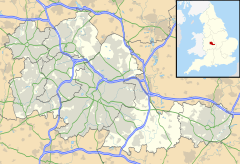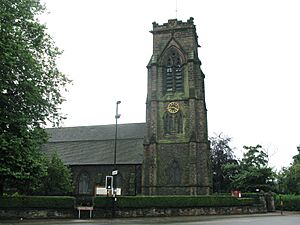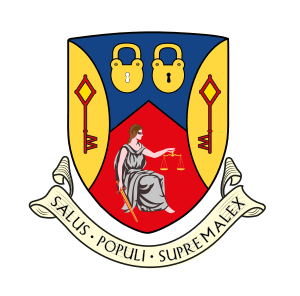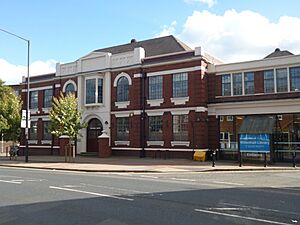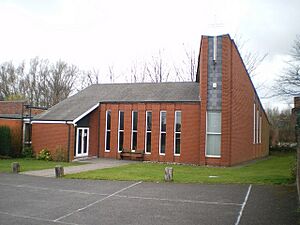Willenhall facts for kids
Quick facts for kids Willenhall |
|
|---|---|
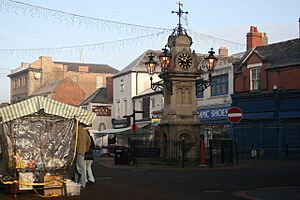 Willenhall Market |
|
 Flag |
|
| Population | 49,587 (2021 Census BUA Profile) |
| OS grid reference | SO9698 |
| Metropolitan borough |
|
| Shire county | |
| Metropolitan county | |
| Region | |
| Country | England |
| Sovereign state | United Kingdom |
| Post town | WILLENHALL |
| Postcode district | WV12, WV13 |
| Dialling code | 01902 |
| Police | West Midlands |
| Fire | West Midlands |
| Ambulance | West Midlands |
| EU Parliament | West Midlands |
| UK Parliament |
|
Willenhall is a market town located in the Walsall area of England. It is part of the West Midlands county. In 2021, about 49,587 people lived here.
The town is found between Wolverhampton and Walsall. It used to be part of Staffordshire. The River Tame flows through Willenhall. The M6 motorway (a major highway) separates it from Walsall.
Willenhall is well-known for making locks and keys. This industry has been important since the 1700s. The town's coat of arms even shows how important locks were to its growth. The town's motto is Salus Populi Suprema Lex, which means "The welfare of the people is the highest law."
Contents
- History of Willenhall
- Future Plans
- Churches in Willenhall
- Willenhall's Industries
- Population Information
- Getting Around Willenhall
- Famous Places in Willenhall
- Schools in Willenhall
- Local Media
- Sports in Willenhall
- Areas of Willenhall
- Fun Places to Visit
- Twin Town
- Famous People from Willenhall
- See also
History of Willenhall
Willenhall is a very old place. Its name comes from an early Saxon settlement. The name Willanhale might mean 'the meadow land of Willa'. Another idea is that it means 'willow halh', which refers to a corner of land with willows, often near a river.
Early Records and Growth
The first time Willenhall was mentioned was in the 700s. King Ethelbald of Mercia signed a treaty there. In 996, it was called Willenhale. Later, in the Domesday Book of 1086, it was listed as Winenhale. It was a very small village back then. It stayed small until industries grew in the 1700s.
In the 900s, Willenhall was in the Shire of Stafford. It was part of a larger area called The Hundred of Offlow. This area had about 30 households and 120 people. For a long time, people had to go to St. Peter's Collegiate Church, Wolverhampton for important events like weddings. Willenhall got its own main church, St. Giles, in 1840. The church you see today is the third one built on that spot, from 1867.
Willenhall was a farming village for many years. From the 1500s, people started using the natural minerals found there. Iron was sent to furnaces nearby. Then, the iron came back to be made into small metal items. Nails were a common product. By the late 1600s, Willenhall was good at making things like grid irons, bolts, and coffin handles.
In 1665, Willenhall had 136 homes and 894 people. The biggest building was the Leveson Manor House. The town's population grew a lot in the 1700s. This was when iron and coal were used more. The town grew around the Market Place and Stafford Street. Many small streets were filled with houses, workshops, and pubs. Old buildings like Dale House and 33 Market Place show how the town became richer.
The Great Fire and Health Improvements
Willenhall had a big fire in 1659. Most of the town centre was destroyed. Many homes were made of wood and mud, which burned easily. When people rebuilt, they used bricks if they could afford it. The Bell Inn Public House, built in 1660, is a good example of a brick building from that time.
The town's first workhouse opened in 1741. By 1801, the population was 3,143.
In 1849, a serious illness called cholera spread through the town. 292 people died. Many were buried in a special Cholera Burial Ground. A plaque there remembers this sad time. It says that 292 people died in 49 days.
This epidemic made the town realize it needed to improve. In 1854, the Willenhall Local Board of Health was started. They built a library in 1866. This board later became the Willenhall Urban District Council in 1894.
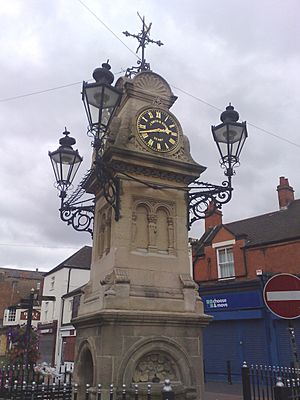
The clock in the Market Place was put up in 1892. It remembers Joseph Tonks, a doctor who helped the town after the cholera outbreak. He brought better health and sanitation to Willenhall.
Willenhall used to be a small area within the parish of Wolverhampton. In 1866, it became its own parish. In 1894, it became an urban district. This district included Willenhall and later Short Heath. In 1966, the district was split up. Parts went to Walsall and Wolverhampton.
Willenhall in the 1900s
By 1901, Willenhall had a population of 18,515 (not counting Short Heath).
Football became popular in Willenhall in 1905. The Spring Bank Stadium opened for the local team, Willenhall Swifts F.C. The club later merged to form Willenhall F.C.. They won a league championship in 1922. The stadium was later used for greyhound racing until 1980.
Another football club, Willenhall Town F.C., started in 1953. They played at Noose Lane until 2013. Since 2010, the ground has been home to Sporting Khalsa F.C..
After World War I, two war memorials were built. They remember the many men from Willenhall who died in the war. A memorial park opened in 1922.
The town's first cinema, the Coliseum, opened in 1914. Two more cinemas followed. The last one closed in 1967. That building is now a pub.
As the population grew, more homes were needed. In 1920, the first council houses were built. Thousands more homes were built over the next 50 years. Willenhall Town Hall was finished in 1935. Public baths were built in 1939.
Most of Willenhall became part of Walsall in 1966. However, some areas, like Portobello, became part of Wolverhampton.
By the late 1970s, local industries were slowing down. By 2000, most lock-making factories had closed or moved. The old Yale factory was taken down in 2009. A Morrisons supermarket opened there in 2010.
Today, the town's main street still has many old buildings. These have been important landmarks for over a hundred years.
Future Plans
Much of Willenhall town centre is a special conservation area. There are plans to improve local buildings with funding from the Heritage Lottery. So, the town centre is expected to get some updates soon. Old factories on the edge of town are being replaced with new homes.
There are also plans to reopen Willenhall Bilston Street railway station for passengers in 2025.
Churches in Willenhall
Willenhall has four main churches of the Church of England: St. Giles', St. Stephen's, St. Anne's, and Holy Trinity.
St. Giles' Church
St. Giles' is the oldest church in Willenhall. Before 1846, it was a "chapel of ease." This meant it was a smaller church for people who couldn't easily travel to the main church in Wolverhampton. The first medieval church was taken down in 1748 because it was old and decaying. A new church was built and opened in 1750. In 1848, it became a full parish church.
St. Stephen's Church
The Parish Church of St. Stephen's is named after St. Stephen the Martyr. It took six years to raise money for the church. It was built and officially opened on October 31, 1854. The church started to fall apart in the late 1900s due to dry rot. It was taken down in 1978. A new church was built and opened in 1979. Many statues from the old church were moved to the new one.
St. Anne's Church
St Anne's Church was also built as a chapel of ease in 1858. It became a parish church in 1861. In the 1970s, the inside of the church was changed. After some repairs in the 2000s, unfortunately, much of the lead was stolen from its roof.
Holy Trinity Church
Holy Trinity Church is in Short Heath. It was officially opened on July 25, 1855. The parish for Holy Trinity was set up in 1846. Services were held in other rooms until the church was built. It was mostly paid for by local business owners.
Willenhall's Industries
Willenhall is famous for making locks. You can visit the Locksmith's House (The Lock Museum) to see how lock makers lived and worked in the early 1900s. This museum is run by the Black Country Living Museum. It shows how a family made locks in their home workshop. The Locksmith's House is on New Road.
To make trade easier, New Road was built before 1820. It helped traffic avoid the busy main street. Outside the town, smaller communities grew around local industries. Areas like Lane Head and Sandbeds had coal mining. Portobello grew because of brickmaking.
There was a lot of coal mining in Willenhall until the 1800s. The industry stopped suddenly after a strike. The mines flooded and were lost.
Lockmaking started in the area during Elizabethan times. It was mainly in Wolverhampton, Willenhall, and Bilston. Eventually, it became focused in Willenhall. Lock making often started as a cottage industry. Families made locks and parts in small sheds behind their homes. Because workers spent long hours bent over their work, some developed humps on their backs. The town became known as 'Humpshire' because of this.
Even in 1956, some local men still had humps. Some pubs even had special holes in the walls behind the seats. This allowed people with humps to sit comfortably. The Bell Inn in Market Street is an example of a pub that had these curved holes.
Rushbrook's was a bakery in Market Street. In 1853, Rushbrook's made their own "Rushbrook Farthing." This was a special coin used by tradesmen in the area. In the 1960s, a pub was renamed The Rushbrook Farthing to remember this unique practice.
Population Information
In 2021, Willenhall's population was 49,587. This makes it the second-largest town in the Walsall Borough, after Walsall itself. Here's a look at the different groups of people living in Willenhall:
| : Willenhall: 2021 Census | |||||||||||||
| Ethnic group | Population | % | |||||||||||
|---|---|---|---|---|---|---|---|---|---|---|---|---|---|
| White | 38,301 | 77.3% | |||||||||||
| Asian or Asian British | 6,184 | 12.5% | |||||||||||
| Mixed | 2,043 | 4.1% | |||||||||||
| Black or Black British | 1,887 | 3.8% | |||||||||||
| Other Ethnic Group | 1,120 | 2.3% | |||||||||||
| Arab | 33 | 0.1% | |||||||||||
| Total | 49,587 | 100% | |||||||||||
Here's a look at the religious groups in Willenhall in 2021:
| Willenhall: Religion: 2021 Census | |||||||||||||
| Religious | Population | % | |||||||||||
|---|---|---|---|---|---|---|---|---|---|---|---|---|---|
| Christian | 22,764 | 48.3% | |||||||||||
| Irreligious | 17,218 | 36.6% | |||||||||||
| Sikh | 4,937 | 10.5% | |||||||||||
| Muslim | 1,103 | 2.3% | |||||||||||
| Hindu | 655 | 1.4% | |||||||||||
| Other religion | 327 | 0.7% | |||||||||||
| Buddhist | 78 | 0.3% | |||||||||||
| Jewish | 11 | 0.1% | |||||||||||
| Total | 49,587 | 100% | |||||||||||
These tables show that Willenhall has a mix of different ethnic and religious groups. It has one of the highest Sikh populations in the West Midlands.
Getting Around Willenhall
Public Transport
Willenhall has good bus services. The 529 bus route connects the town centre to Walsall and Wolverhampton. Buses run often during the day. Other bus routes link Willenhall to nearby areas like Wednesfield and Darlaston.
There isn't one big bus station. You can catch buses at the 'Market Place' stops and the Lower Lichfield Street stop. These are good places to change buses.
Most bus routes are run by National Express West Midlands. Other companies like Diamond West Midlands and Carolean Coaches also operate services.
Willenhall doesn't have many other public transport options. Both of its old railway stations closed over 40 years ago. Plans to reopen the station at Bilston Street secured funding in March 2018. The station was set to reopen by the end of 2021, giving Willenhall a train connection for the first time since 1965.
The town is not currently served by the West Midlands Metro light rail system. However, there are plans for a new route called the '5 W's' Route. This would connect Willenhall to Wednesfield, Wolverhampton, Wednesbury, and Walsall. There are also plans for a line from Stourbridge to Wednesfield through Willenhall. This is planned to start construction in the late 2020s.
Roads and Businesses
Willenhall is about a 10-minute drive from Junction 10 of the M6. Many main roads go through the area. These include The Keyway and the A454, also known as The Black Country Route.
Because of its central location, Willenhall is home to important distribution centres. These include Poundland and transport companies like Aspray and DX Freight. Also, the dairy company Müller Milk & Ingredients has a depot here.
Famous Places in Willenhall
Some of the main landmarks in Willenhall are:
- The Locksmith's House museum on New Road.
- The cholera burial ground in Doctors Piece.
- St Giles Church.
- The bandstand in Willenhall Park.
- The Clock Tower in the Market Place.
- The Bell Inn, an old pub.
- The malthouse (now a shop called Davey's Locker).
- The Lock and Key sculptures in the market place.
- Dale House (now a restaurant).
- The Dale cinema (now a Wetherspoon's pub).
- The Toll House (now a restaurant).
- The old Town Hall (now the library) in Walsall Street.
Schools in Willenhall
Willenhall has three secondary schools:
- St Thomas More Catholic School
- Willenhall E-Act Academy (formerly Willenhall Comprehensive School)
- Pool Hayes Academy (formerly Pool Hayes Arts and Community School)
There is also Moseley Park School.
For younger students, Willenhall has many primary schools:
- Fibbersley Park Academy – A large school near Willenhall Park.
- Short Heath Junior School, Rosedale CofE Primary School & Lane Head Nursery School – Three schools located near the Lodge Farm Estate.
- Barcroft School – Formed from the merger of Elm Street Infants and Albion Road Juniors.
- Woodlands Primary – Located in the Short Heath area.
- Lodge Farm Primary – Located next to Willenhall School Sports College.
- New Invention Junior/Infants – Two successful schools in New Invention.
- Beacon Primary – A large school in the middle of the New Invention Estate.
- St. Giles CofE Primary School – A combined nursery, infant, and primary school next to St. Giles church.
- Pool Hayes Primary School – Located on the Summer Hayes estate.
Local Media
You can get local news and TV programs from BBC West Midlands and ITV Central. Radio stations include BBC Radio WM, Heart West Midlands, and Greatest Hits Radio Black Country & Shropshire. The local newspaper is the Express & Star.
Sports in Willenhall
Football
The town has two football clubs: Northwich Victoria F.C. and Sporting Khalsa F.C..
In the 2005/06 season, Willenhall won the Birmingham Senior Cup. Their most successful time was in the early 1980s. They reached the first round of the FA Cup in 1981–82. They were also runners-up in the FA Vase in 1981.
Sporting Khalsa won the West Midland Premier League in 2014–15. They reached the 4th Qualifying round of the FA Cup, playing against F.C. United of Manchester in front of over 2,200 fans.
Rugby
Willenhall also has its own rugby union football club. It was started in 1966 by employees of Rubery Owen. They are based in nearby Essington.
Greyhound Racing
Willenhall Greyhound Stadium was a place for greyhound racing from 1932 to 1980.
Areas of Willenhall
- Short Heath
- New Invention
- Lodge Farm
- Poet's Estate
- Rough Wood
- Coppice Farm
- Portobello
- Fibbersley
- Allens Rough
- Little London
- The Crescent
- The Summers
- St Anne's
- Manor Farm
- County Bridge
- Summer Hayes
- Sneyd
- Scholars Heath
- Rose Hill
- Lakeside
- Park Side
- St Giles
- Lane Head
- Neachells
Fun Places to Visit
- Willenhall Memorial Park
- Fibbersley Nature Trail and Reserve
- Rough Wood Chase
- The Summers
- Coppice Farm Open Space
- Old Bentley Canal walk
- Short Heath Park
Twin Town
Willenhall is twinned with:
- Drancy, France. An agreement was signed in Drancy on November 29, 1959. In 2019, a group from Willenhall visited Drancy to celebrate 60 years of this friendship. A road in Willenhall is named Drancy Avenue.
Famous People from Willenhall
- Richard Wilkes (1691–1760), a historian and doctor who lived locally.
- Charles Lapworth (1878–1951), a journalist and film promoter.
- Miriam Tildesley MBE (1883–1979), an educator and museum curator.
- Rob Collins (1963–1996), a musician from the band The Charlatans.
Sports Stars
- Bert Bliss (1890–1968), a footballer who played many games for Spurs.
- Jack Southam (1917–1996), a footballer who played for Northampton Town F.C..
- Jack Pitt (1920–2004), a footballer who played for Bristol Rovers F.C..
- Frank Clarke (1942–2022), a footballer who played for Shrewsbury Town F.C..
- Allan Clarke (born 1946), a footballer who played for Leeds United.
- Derek Clarke (born 1950), a footballer who played for Oxford United F.C..
- Mark Davies (born 1988), a footballer who played for Bolton Wanderers F.C..
- Glyn Marston (born 1962), an ultra-distance runner and charity fundraiser. He ran very long distances and broke world treadmill records. He also ran across the Grand Canyon.
See also
 In Spanish: Willenhall para niños
In Spanish: Willenhall para niños


